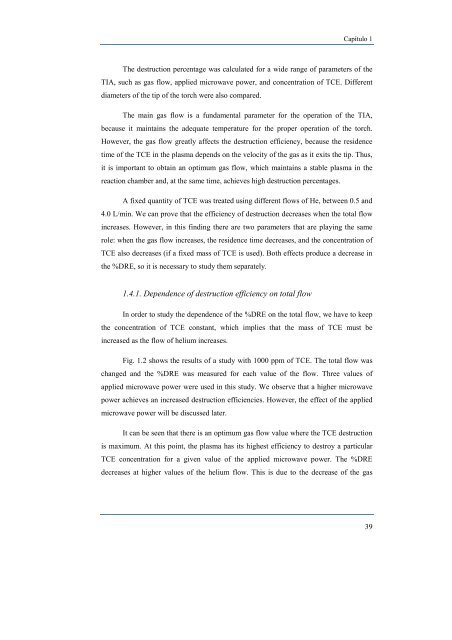estudio y caracterización de un plasma de microondas a presión ...
estudio y caracterización de un plasma de microondas a presión ...
estudio y caracterización de un plasma de microondas a presión ...
You also want an ePaper? Increase the reach of your titles
YUMPU automatically turns print PDFs into web optimized ePapers that Google loves.
Capítulo 1<br />
The <strong>de</strong>struction percentage was calculated for a wi<strong>de</strong> range of parameters of the<br />
TIA, such as gas flow, applied microwave power, and concentration of TCE. Different<br />
diameters of the tip of the torch were also compared.<br />
The main gas flow is a f<strong>un</strong>damental parameter for the operation of the TIA,<br />
because it maintains the a<strong>de</strong>quate temperature for the proper operation of the torch.<br />
However, the gas flow greatly affects the <strong>de</strong>struction efficiency, because the resi<strong>de</strong>nce<br />
time of the TCE in the <strong>plasma</strong> <strong>de</strong>pends on the velocity of the gas as it exits the tip. Thus,<br />
it is important to obtain an optimum gas flow, which maintains a stable <strong>plasma</strong> in the<br />
reaction chamber and, at the same time, achieves high <strong>de</strong>struction percentages.<br />
A fixed quantity of TCE was treated using different flows of He, between 0.5 and<br />
4.0 L/min. We can prove that the efficiency of <strong>de</strong>struction <strong>de</strong>creases when the total flow<br />
increases. However, in this finding there are two parameters that are playing the same<br />
role: when the gas flow increases, the resi<strong>de</strong>nce time <strong>de</strong>creases, and the concentration of<br />
TCE also <strong>de</strong>creases (if a fixed mass of TCE is used). Both effects produce a <strong>de</strong>crease in<br />
the %DRE, so it is necessary to study them separately.<br />
1.4.1. Depen<strong>de</strong>nce of <strong>de</strong>struction efficiency on total flow<br />
In or<strong>de</strong>r to study the <strong>de</strong>pen<strong>de</strong>nce of the %DRE on the total flow, we have to keep<br />
the concentration of TCE constant, which implies that the mass of TCE must be<br />
increased as the flow of helium increases.<br />
Fig. 1.2 shows the results of a study with 1000 ppm of TCE. The total flow was<br />
changed and the %DRE was measured for each value of the flow. Three values of<br />
applied microwave power were used in this study. We observe that a higher microwave<br />
power achieves an increased <strong>de</strong>struction efficiencies. However, the effect of the applied<br />
microwave power will be discussed later.<br />
It can be seen that there is an optimum gas flow value where the TCE <strong>de</strong>struction<br />
is maximum. At this point, the <strong>plasma</strong> has its highest efficiency to <strong>de</strong>stroy a particular<br />
TCE concentration for a given value of the applied microwave power. The %DRE<br />
<strong>de</strong>creases at higher values of the helium flow. This is due to the <strong>de</strong>crease of the gas<br />
39

















